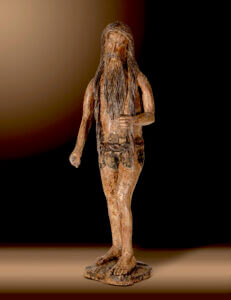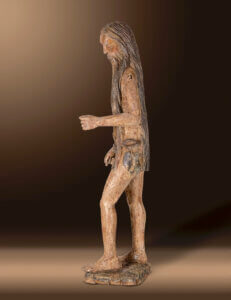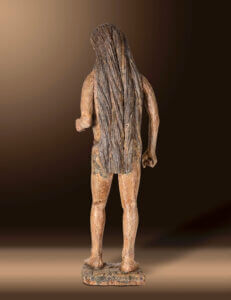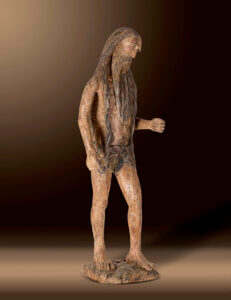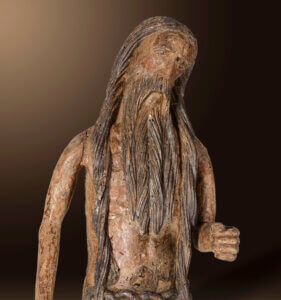St. Onuphrius, or Onuphrius the Great, was born around 320 and died around 400 A.D. The name possibly comes from the Coptic word Unnufer, which means “the eternally good”. After being rejected by his father, he lived in a monastery for some time before retiring to the desert as a hermit. He is venerated in the Coptic, Orthodox and Catholic faiths and numerous churches are dedicated to him. Interestingly, St. Onuphrius is venerated as the city saint of Munich. The legendary founder of Munich, Henry the Lion, acquired Onuphrius’ braincase on a crusade in the 12th century and brought it to Munich as a relic. However, the chapel in which it was kept was demolished in the 19th century, as a result of which all trace of the relic was lost.
This captivating, late Gothic sculpture of Saint Onuphrius shows the ascetic saint in typical fashion as an elderly man with long hair and a flowing beard, which emphasize his years of devotion and solitude. His upper body is almost concealed by two parallel strands of hair and the beard. Standing in a contemplative posture, his eyes are turned thoughtfully downwards, conveying a deep sense of introspection and spiritual concentration. His slender, aged body is naked and covered only at the loins with vines and heart-shaped leaves, symbolizing his renunciation of worldly possessions and his reclusive life in the desert. His hands are raised and probably originally held other attributes such as a walking stick. His head is tilted thoughtfully downwards, his face turned towards the viewer, with the accentuated eyebrow ridges and drawn-together eyebrows conveying a moment of concentration. A comparable depiction from the same period with foliage as a loincloth can be found in the chapel of St. George in Peißenberg in the Upper Bavarian district of Weilheim-Schongau, which is attributed to the so-called “Master of the Untermenzing Altarpieces”. However, this is depicted with a fur robe, while the hermit status of the figure presented here is particularly emphasized by the nudity in contrast to the head and beard hair.
The intricate details of the carving, from the textured strands of his beard to the naturalistic depiction of the leaves, emphasize his humility and devotion. This depiction captures the essence of St. Onuphrius as a figure of deep faith, self-denial and communion with nature, inviting the viewer to reflect on the saint’s life and engage in meditation as well.
Literature:
Johannes Glötzner, Onuphrius. Patron saint of the city of Munich and the hermaphrodites, Munich 2008.
Gisela Schinzel-Penth, Sagen und Legenden von München, Frieding 20003, pp. 26-28.
Ekkart Sauser, “Onuphrios der Große”, in: Biographisch-Bibliographisches Kirchenlexikon, Vol. 14, Herzberg 1998, Sp. 1333-1334.
